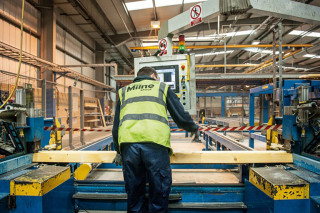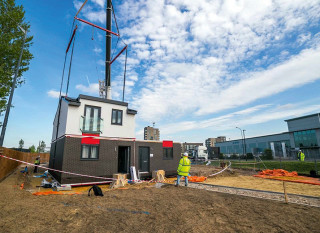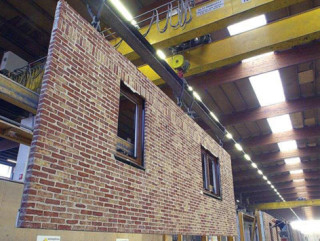Does the idea of a government body focused on helping smaller firms into the house-building market sound too good to be true?
Well, there is one. And if it’s held to its bold statements, an awful lot of houses will be built, helped by public land and money, and not just built by the usual suspects. Those that benefit most are thought likely to have to engage with off-site construction.
Homes England is the successor to the Homes & Communities Agency (HCA) but shorn of the part that oversaw housing associations - that has gone to the unimaginatively-named Regulator of Social Housing.
As for Homes England, it looks and sounds noticeably different from the often bureaucratic HCA.
Take this from its chair, Sir Edward Lister, who was London’s deputy mayor for policy and planning under Boris Johnson:
“At the most basic level, we have not been building enough homes,” he says.
“This has led to soaring house prices and rising rents…a whole generation can no longer afford to get on the housing ladder. We desperately need more homes in the right places, where people want to live.”
It’s not every day a government agency admits to desperation, in this case in the inability to achieve its target of an average 300,000 new homes a year.
But, desperate or not, Sir Edward boasts of “striking bold deals and forming new types of innovative partnerships to shake up housing delivery”.
Homes England will work with councils and housing associations, assemble land and make it available and will not itself build homes but rather fund “builders of all sizes” to do this.
The organisation has a staff of 750 (a number it intends to double by mid-2020) and a budget of £27bn to invest by 2021-22.
Homes England administers two main funds that help house-builders. First is the Help to Buy scheme which has given builders of all sizes the confidence that they can sell the homes they build; under its equity loan version, money is paid directly to registered house-builders.
Then there’s the £4.5bn Home Building Fund, available for off-site component manufacture, new entrants to housebuilding, self-builders and groups of small firms collaborating to deliver larger sites.
Despite this largesse, some builders may baulk at Homes England’s commitment to off-site manufacture, or ‘modern methods of construction’ (MMC).
Its strategy, published in October 2018, states: “We’ll seek to boost supply, productivity, innovation, quality, skills and the use of MMC in the housing market. We’ll also help to shape a more diverse and resilient market. Our investment will help smaller builders scale up, so that they can access funding privately in their next round of expansion.”
This is not just a pious wish; there is money tied to MMC.

The strategy says MMC would be promoted “through our provision of development finance to developers” and be incorporated into contracts for land and investment.
One example is a joint venture with contractor Kier and social landlord Cross Keys Homes to start work on 18 sites across England by mid-2020. Some 20% of these homes will use MMC and other commitments include 30% affordable homes, at least three new apprenticeships at each site and half of each workforce drawn from local residents.
Homes England says it will “unlock and enable sites for the full spectrum of house-builders and directly deliver enabling infrastructure where necessary”.

However it will not leave the builders to build as they choose.
Instead it will expect them to “commit to delivering the supply that local areas need at pace, and to building high quality homes and developments”. There will also be training obligations.
The emphasis on helping smaller firms ought to be music to the ears of the Federation of Master Builders (FMB) and, to an extent, the FMB likes what it hears. The organisation’s director of external affairs, Sarah McMonagle, says: “Generally, the government and Homes England now recognise the role of small and medium house-builders.
“For far too long they thought all they had to do was get the large house-builders building more, but they now realise smaller firms have a role and they need to get them into this market and keep the ones that are already there.
“The Home Building Fund has been very positive and unlike some other funds not so bureaucratic that few use it. It had to be replenished in the budget which was a good sign.”
There’s a ‘but’ coming… McMonagle thinks the strategy’s section on MMC and productivity is “less positive”.
She explains: “I think they are guilty of over-egging those. There is a role for MMC, but it is not the only dog in the race. What we want is a continued supply of large and small sites.
“When we polled our members a third said they were interested in looking at MMC more closely. That might, though, be for things like modular bathrooms rather than whole houses assembled from components.”
On productivity, the FMB would like to see a higher quality of apprenticeships in areas where it feels quality has fallen in recent years. “But if you can get people properly trained then they will be more productive,” says McMonagle.
Emphasising the role of smaller firms might be expected to ruffle feathers at the Home Builders Federation (HBF), which represents the big volume builders. But the HBF accepts more must be done to assist smaller firms since large firms cannot indefinitely provide extra homes.
A spokesman says: “The majority of the increases we have seen have come from the bigger builders, but there is a limit to how far they can go and we have to develop a wider supply base.
“Homes England recognises the need to reverse the collapse in SME builder output of recent decades to supplement the contribution of the larger companies if we are to get to the required levels of supply.”
The HBF does not share the FMB’s caution about off-site building, though.
“All the larger builders are looking at various aspects of MMC and how they can integrate new technologies into their processes,” says the HBF spokesman.
“MMC has a key part to play but there is no silver bullet and centralised funding to develop and coordinate thinking will help supplement what individual companies are doing.”
Homes England has positioned itself as ‘the builder’s friend’. It is, however, even friendlier to those that take the plunge into MMC.

This article was first published in the December/January 2019 issue of The Construction Index magazine
UK readers can have their own copy of the magazine, in real paper, posted through their letterbox each month by taking out an annual subscription for just £50 a year. Click for details.
Got a story? Email news@theconstructionindex.co.uk



